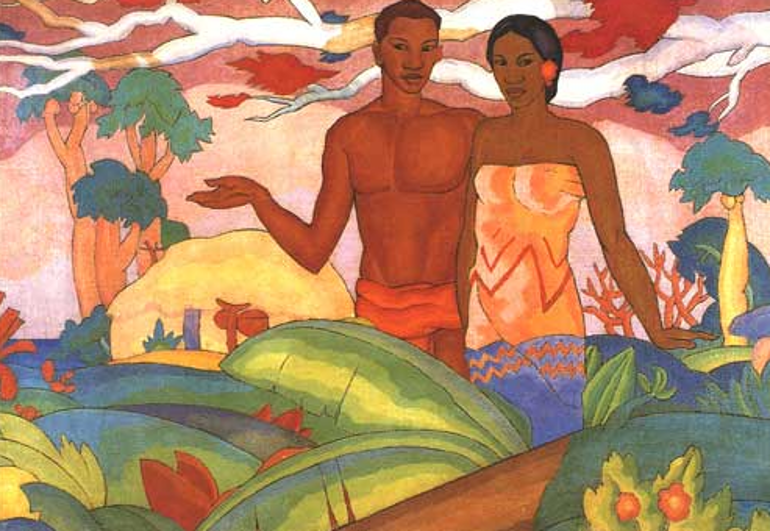The humanity field selected in the previous assignment was “Visual Art,” practiced in many cultures worldwide. As described in the previous assignment, visual art incorporated products like; paints, films, drawings, videos, architecture, sculptures and ceramics that people significantly appreciated through sight. In this case, different examples of visual art were selected from three different cultures; Latin American Culture (Mexico), Western Culture (United States), and Pacific Islander Culture (Native Hawaiian). The selected aspects of visual arts in the selected countries were; Mexican Baroque, made in Mexico; Woman II, Made in the United States; and Fragile Paradise, made in Native Hawaii. I selected visual art in these cultures because they significantly influenced the cultures in different ways. In this context, the three selected examples of visual art in the three cultures share common themes as well as differing in some aspects, as described in the paper.
The first example was the Mexican Baroque, created by Cristobal de Villalpando in Mexico. Mexican Baroque emerged from the conquest of the New World during the subjugation and negotiation that unfolded when the Spaniards established a rule in 1521. Cristobal de Villalpando created Mexican Baroque during his time in the 1680s. Several events followed the establishment of the Mexican Baroque. One of the most significant events was the Renaissance, which started in Rome from 1584 to 1685. The ideas for formulating the Mexican Baroque were derived from the Spanish Baroque. During this time, the artists applied realistic creative approaches making visual art popular. The second visual art analyzed in the assignment was Woman II, created by Willem de Kooning in 1952 in the Museum of Modern Art in New York City (Heathcote 107). The art was created in the 1950s in New York when painters like Fraz Kline and Jackson Pollock were creating their art. During this time, Kooning created Woman II with attractive paintings and colors. Woman II was abstract expressionist oil on canvas painting. It was taken to the Museum of Modern Art in New York City. The third example of visual art was Fragile Paradise, created by Arman Manookian from 1924 to 1925. It was created in Native Hawaii in the Pacific Islander culture (Blackford 23). Fragile Paradise was created to portray the protection of the environment.

Figure 2: Woman II by Willem De Kooning

Figure 3: The Mexican Baroque by Cristibol de Villalpando

One thing in common that the three examples of visual art selected is that the creator applied the same color in painting their artworks. Some colors applied in all three examples are a mixture of yellow, Umber, Ocher and vermillion. Moreover, the three designers applied copper resin and organic carbon black deposits on the background. On the other hand, the three examples have used different colors in painting in different sections. The significant difference is that they do not depict the same theme. Each visual art may tell a different story. The interpretive terms applied in analyzing visual art are the degree of light and dark and the form of the art (Liu 1). The degree of light and darkness will define the appearance of the three examples of visual art. On the other hand, the form describes the visual art’s shape and dimensions. In this case, Fragile Paradise was designed with a clear light. The value of a degree in Woman II is dark, and that of a degree in Mexican Baroque is dark (Malloy 23). The form in the three examples of visual art is two dimensions with width and length.
In conclusion, the Mexican Baroque, Fragile Paradise and Woman II were designed in Mexico by Cristibol de Villalpando, Native Hawaii by Arman Manookian and the United States by Willem Manookian, respectively. Woman II was created in Western Culture, Fragile Paradise was created in Pacific Islander Culture, and Mexican Baroque was created in Latin American Culture. The three examples applied the same form, two dimensions and similar colors in different sections. The three examples differ because they do not depict similar themes.
Works Cited
Blackford, M. G. (2001). Fragile paradise: the impact of tourism on Maui, 1959-2000. Development of Western Resource.
Heathcote, Christopher. “Willem de Kooning and the meaning of his ugly woman.” Quadrant 64.7/8 (2020): 104-113.
Libretexts (2020) 9.5: Mexican baroque (1640 – the mid-1700s), Humanities LibreTexts. Available at: https://human.libretexts.org/Courses/Solano_Community_College/ART_002:_Art_History/09:_The_Beginning_of_Colonization_(1550_CE__1750_CE)/9.05:_Mexican_Baroque_(1640__mid_1700s) (Accessed: 29 June 2023).
Liu, Wenli. “Research on the application of multimedia elements in visual communication art under the Internet background.” Mobile Information Systems 2021 (2021): 1-10.
Malloy, Kaoiṁe E. The art of theatrical design: elements of visual composition, methods, and practice. Taylor & Francis, 2022.
 write
write